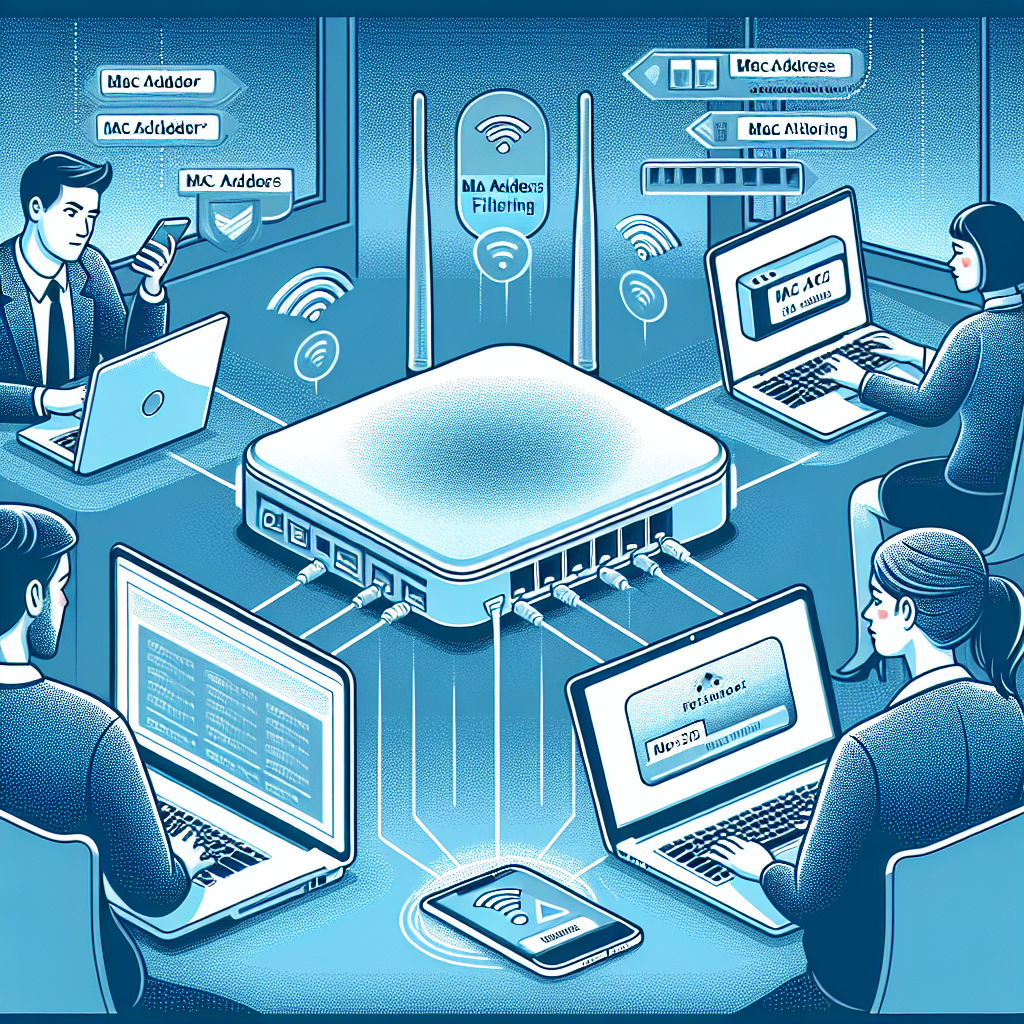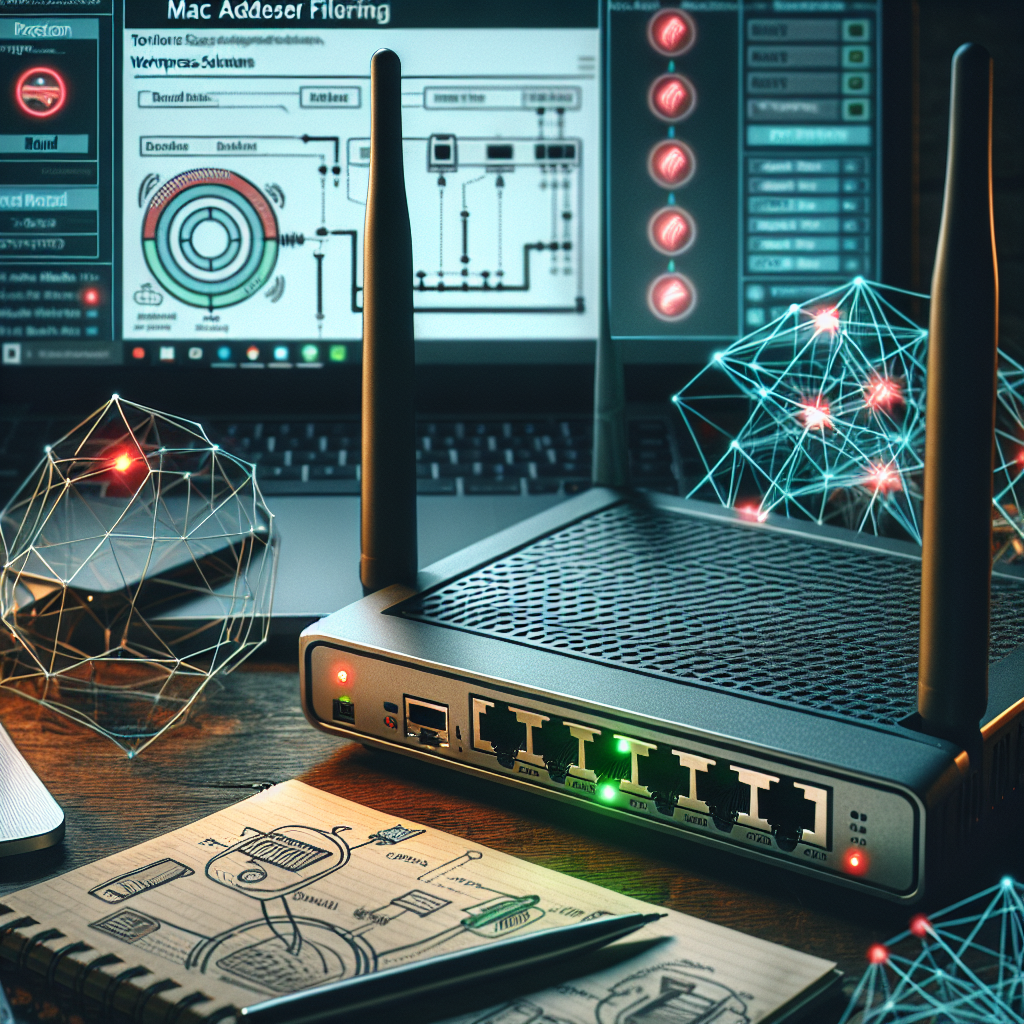
In today’s fast-paced world, the need for secure and efficient hotspot solutions has never been greater. One popular method that businesses and organizations are using to enhance their Wi-Fi security is MAC address filtering. By implementing this technology, network administrators can control which devices are allowed to connect to their hotspot, thereby reducing the risk of unauthorized access. This proactive approach not only provides peace of mind for users, but also ensures a smooth and reliable internet experience. Join us as we explore the benefits and advantages of hotspot solutions with MAC address filtering.
Understanding Hotspot Solutions

Hotspot solutions refer to systems or technologies that provide users with wireless internet access, typically in public locations such as cafes, airports, or hotels. These solutions are designed to offer convenient and reliable connectivity to individuals on the go, allowing them to access the internet from their devices without the need for physical connections.
Definition of hotspot solutions
Hotspot solutions can take various forms, including Wi-Fi hotspots, mobile hotspots, and captive portal systems. Wi-Fi hotspots use wireless access points to create network zones where users can connect to the internet using Wi-Fi-enabled devices. Mobile hotspots, on the other hand, leverage cellular data networks to provide internet access to users through devices like smartphones or portable routers. Captive portal systems require users to authenticate themselves before gaining access to the internet, often through a login page or other verification methods.
Importance of reliable and secure internet connectivity
Reliable and secure internet connectivity is crucial for hotspot solutions to ensure that users can access the internet seamlessly and without compromising their data security. A stable connection is essential for users to browse the web, stream media, or conduct online transactions without interruptions or delays. Security measures such as encryption protocols, firewalls, and authentication mechanisms help protect users’ data from unauthorized access or cyber threats, safeguarding their privacy and sensitive information while using hotspot services.

Exploring MAC Address Filtering
Explanation of MAC addresses
MAC (Media Access Control) addresses are unique identifiers assigned to network interfaces for communications on a network. These addresses are composed of 12-character hexadecimal numbers, organized in pairs separated by colons or hyphens. Each device connected to a network, such as smartphones, laptops, or IoT devices, has a unique MAC address that distinguishes it from others on the same network.
How MAC address filtering works in hotspot solutions
MAC address filtering is a security feature implemented in hotspot solutions to control which devices can connect to the network. By configuring a list of approved MAC addresses, the hotspot restricts access to only those devices with their MAC addresses added to the list. When a device attempts to connect to the hotspot, the access point checks the device’s MAC address against the approved list. If the MAC address is on the list, the device is granted access; otherwise, it is denied connection.
Benefits of using MAC address filtering for network security
- Enhanced Access Control: MAC address filtering provides an additional layer of access control by allowing network administrators to specify which devices are permitted to connect to the hotspot. This helps in preventing unauthorized devices from accessing the network.
- Improved Security: By restricting network access to authorized devices only, MAC address filtering reduces the risk of unauthorized access, potential intrusions, and security breaches. It adds an extra barrier against malicious actors trying to gain access to the network.
- Simplified Device Management: Managing a network with MAC address filtering is streamlined as administrators can easily update the list of approved devices and revoke access for unauthorized ones. This simplifies device management and ensures better network security hygiene.
Enhancing Security with MAC Address Filtering
xploring MAC Address Filtering
Implementing MAC address filtering in hotspot solutions plays a crucial role in enhancing security measures within a network environment. By utilizing this method, network administrators can significantly reduce the risk of unauthorized access and potential cyber threats.
-
Preventing unauthorized access to the network: MAC address filtering acts as a barrier that only allows devices with approved MAC addresses to connect to the network. This restriction prevents unauthorized devices from gaining entry, thereby safeguarding the network from potential intruders.
-
Mitigating risks of cyber threats and attacks: By filtering MAC addresses, network administrators can effectively minimize the chances of malicious activities such as man-in-the-middle attacks or unauthorized data interception. This proactive measure adds an extra layer of security, making it harder for cybercriminals to breach the network.
-
Securing sensitive data and information: MAC address filtering helps in securing sensitive data and information by ensuring that only trusted devices can communicate within the network. This restriction limits the exposure of confidential data to unauthorized devices, reducing the likelihood of data breaches or leaks.
Improving Efficiency with MAC Address Filtering
Implementing MAC address filtering within hotspot solutions is a powerful method to enhance network efficiency. By controlling access based on unique MAC addresses assigned to each device, networks can experience several benefits:
-
Streamlining network management: MAC address filtering allows administrators to easily identify and manage devices connected to the network. This streamlined approach simplifies the monitoring of authorized devices, reducing the risk of unauthorized access and potential security breaches.
-
Optimizing bandwidth usage: With MAC address filtering in place, network administrators can prioritize bandwidth allocation for authorized devices. By assigning specific bandwidth limits or restrictions based on MAC addresses, organizations can ensure that critical applications receive the necessary resources while preventing bandwidth abuse by unauthorized users.
-
Enhancing overall network performance: By filtering MAC addresses, networks can experience improved performance due to reduced congestion and optimized traffic flow. Authorized devices can enjoy faster and more reliable connections, leading to a better user experience and increased productivity for users accessing the network.
Implementing MAC Address Filtering in Hotspot Solutions
Implementing MAC Address Filtering in Hotspot Solutions
MAC address filtering is a powerful tool in hotspot solutions that allows network administrators to control which devices can connect to the network based on their unique MAC addresses. By implementing MAC address filtering, organizations can enhance security and restrict unauthorized access to their network. Below is a detailed guide on how to effectively set up MAC address filtering in hotspot solutions:
-
Step-by-step guide to setting up MAC address filtering:
-
Access the hotspot solution’s administrative interface or dashboard.
- Locate the MAC address filtering settings within the network configuration options.
- Choose the option to enable MAC address filtering.
- Enter the MAC addresses of the devices you wish to allow or block from accessing the network.
- Save the changes and apply the MAC address filtering rules.
-
Test the network connection to ensure that only the specified devices can connect.
-
Best practices for configuring MAC address filtering:
-
Regularly update the list of allowed and blocked MAC addresses to maintain network security.
- Avoid using easily guessable MAC addresses for added protection.
- Document the MAC addresses of authorized devices to streamline the configuration process.
-
Consider implementing a combination of MAC address filtering with other security measures for a layered defense approach.
-
Common challenges and how to overcome them:
-
Limited scalability: As the number of devices grows, managing MAC addresses manually can become cumbersome. To overcome this challenge, consider using automated tools or network management software that can streamline the process.
-
Spoofing attacks: Attackers can spoof MAC addresses to bypass filtering rules. To mitigate this risk, regularly monitor network activity for anomalies and consider implementing additional security measures such as encryption protocols.
-
Compatibility issues: Some devices may have MAC address randomization features that can interfere with filtering rules. To address this challenge, ensure that devices are properly configured to comply with the network’s MAC address filtering policies.
Tips for Effective Implementation
Implementing MAC address filtering in hotspot solutions requires strategic planning and continuous monitoring to ensure network security. To effectively enhance the efficiency and reliability of this security measure, consider the following tips:
-
Regularly updating the MAC address whitelist: It is essential to consistently review and update the list of approved MAC addresses. New devices may need to be added, while obsolete or unauthorized devices should be promptly removed. By keeping the whitelist current, you can prevent unauthorized access and maintain a secure network environment.
-
Monitoring network activity and anomalies: Actively monitoring network activity can help detect any irregularities or suspicious behavior that may indicate unauthorized access attempts. By analyzing traffic patterns and identifying anomalies, you can respond swiftly to potential security breaches and strengthen the overall effectiveness of MAC address filtering.

– Integrating MAC address filtering with other security measures: While MAC address filtering can provide a valuable layer of security, it is essential to complement this measure with other security protocols. Integrating MAC address filtering with encryption, authentication mechanisms, and firewall protection can create a more robust defense against cyber threats. By combining multiple security measures, you can establish a comprehensive security framework that safeguards your hotspot network effectively.
Addressing Misconceptions about MAC Address Filtering
Debunking myths about MAC address security
- One common misconception about MAC address filtering is that it provides foolproof security for networks. In reality, MAC addresses can be easily spoofed, rendering this method vulnerable to unauthorized access.
- Another myth is that MAC address filtering alone is sufficient to protect a network from intruders. While it can act as a deterrent, it should be complemented with other robust security measures for comprehensive protection.
- It is important to understand that MAC address filtering does not encrypt data or prevent eavesdropping. It simply controls access based on a device’s unique MAC address, making it essential to combine with encryption protocols for enhanced security.
Clarifying the limitations of MAC address filtering
- Despite its usefulness in restricting access to authorized devices, MAC address filtering is not a foolproof method for securing a network. It can be time-consuming to manage a large number of MAC addresses and may not prevent sophisticated attacks.
- MAC addresses are transmitted in plaintext, making them susceptible to interception and spoofing. This limitation highlights the need for additional security measures such as WPA3 encryption and strong authentication protocols.
- It is crucial to recognize that MAC address filtering only provides a basic level of security and should be used in conjunction with other advanced security technologies to create multiple layers of defense against cyber threats.
Exploring additional layers of security for comprehensive protection
- To enhance the security of a network that utilizes MAC address filtering, implementing a robust firewall is essential. Firewalls can monitor and control incoming and outgoing network traffic, adding an extra layer of protection against unauthorized access.
- Intrusion detection systems (IDS) and intrusion prevention systems (IPS) can complement MAC address filtering by actively monitoring network traffic for suspicious activity and blocking potential threats in real-time.
- Regular security audits and updates are crucial to maintaining the effectiveness of MAC address filtering and other security measures. By continuously assessing and improving security protocols, organizations can stay ahead of evolving cybersecurity threats and safeguard their networks effectively.
Future Trends in Hotspot Solutions and MAC Address Filtering
The landscape of hotspot solutions and MAC address filtering is continuously evolving, driven by technological advancements and the ever-growing need for robust network security measures. As we look towards the future, several trends are shaping the direction of these technologies:
-
Advancements in Hotspot Technology:
- The integration of Artificial Intelligence (AI) and Machine Learning (ML) algorithms into hotspot management systems is poised to revolutionize the way hotspots are deployed and managed. These technologies can analyze network traffic patterns in real-time, detect anomalies, and proactively prevent security breaches.
- The widespread adoption of 5G networks is expected to significantly enhance the speed and reliability of hotspots, offering users seamless connectivity even in highly congested areas. This will enable businesses to deploy high-performance hotspots that can support bandwidth-intensive applications and services.
- The rise of Internet of Things (IoT) devices necessitates hotspot solutions that can accommodate a multitude of connected devices simultaneously. Future hotspots will need to be equipped with advanced traffic prioritization mechanisms to ensure optimal performance for both IoT devices and traditional endpoints.
-
Emerging Trends in Network Security:
- With the increasing sophistication of cyber threats, hotspot solutions are placing greater emphasis on proactive security measures. Technologies such as Intrusion Detection Systems (IDS) and Intrusion Prevention Systems (IPS) are becoming integral components of hotspot security frameworks, enabling real-time threat detection and mitigation.
- Zero Trust Security models are gaining traction in hotspot deployments, emphasizing the principle of “never trust, always verify.” This approach requires strict access controls and continuous authentication checks, reducing the risk of unauthorized access to the network.
- The convergence of physical and digital security is shaping the future of hotspot security. Biometric authentication methods, such as fingerprint scanning and facial recognition, are being integrated into hotspot access control systems to enhance security while ensuring a seamless user experience.
-
Potential Developments in MAC Address Filtering:
- The traditional approach to MAC address filtering, which involves creating static lists of approved MAC addresses, is evolving towards more dynamic and adaptive filtering mechanisms. Future MAC address filtering solutions may leverage AI algorithms to analyze network traffic patterns and automatically adjust filtering rules based on user behavior.
- Enhanced integration with Identity and Access Management (IAM) systems is expected to streamline the management of MAC address filtering policies. By aligning MAC address filtering with user identity management, organizations can enforce granular access controls and ensure compliance with regulatory requirements.
- The concept of MAC address randomization, employed by some devices to enhance privacy and security, presents challenges for traditional MAC address filtering techniques. Future developments may focus on addressing these challenges through innovative approaches that balance security and user privacy concerns.
FAQs: Hotspot Solutions with MAC Address Filtering
What is MAC address filtering in the context of hotspot solutions?
MAC address filtering is a security feature that allows network administrators to control which devices can access a network based on their unique MAC addresses. By creating a whitelist of approved MAC addresses, only devices with those specific addresses are able to connect to the network, providing an additional layer of security against unauthorized access.
How does MAC address filtering enhance the security of a hotspot solution?
MAC address filtering enhances the security of a hotspot solution by limiting access to only those devices whose MAC addresses have been specifically approved by the network administrator. This helps prevent unauthorized devices from connecting to the network, reducing the risk of security breaches and ensuring that only trusted devices can access the hotspot.
Can MAC address filtering be easily implemented in hotspot solutions?
Yes, MAC address filtering can be easily implemented in hotspot solutions with the right tools and configurations. Most modern router and hotspot devices come equipped with MAC address filtering capabilities, allowing network administrators to easily set up and manage a whitelist of approved devices. By simply adding the MAC addresses of authorized devices to the filter list, administrators can ensure that only those devices are able to connect to the hotspot.
Are there any limitations or drawbacks to using MAC address filtering in hotspot solutions?
While MAC address filtering can enhance security, it is not foolproof and may not provide complete protection against determined attackers. MAC addresses can be spoofed or cloned, allowing unauthorized devices to masquerade as approved devices and gain access to the network. Additionally, managing a large number of MAC addresses in the filter list can be cumbersome and time-consuming for network administrators. As such, MAC address filtering should be used in conjunction with other security measures to create a comprehensive security strategy for hotspot solutions.